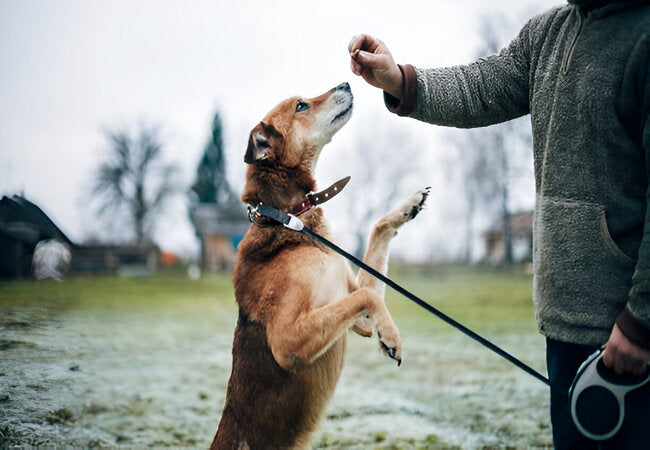Balanced Dog Training vs Positive Reinforcement in 2025 – Vet‑Approved Training Guide 🐕🦺🎓

In this article
Balanced Dog Training vs Positive Reinforcement in 2025 – Vet‑Approved Training Guide 🐕🦺🎓
By Dr. Duncan Houston BVSc
Dog training has evolved significantly in recent years. The debate between balanced training and positive‑reinforcement methods isn’t just theoretical—it impacts your dog’s wellbeing, learning ability, and trust in you. In this 2025 guide, I’ll walk you through what each method entails, the evidence behind them, and how you can choose or integrate methods to benefit your unique dog. Let's get started! 🧠🐾
1. What Are These Methods?
Positive reinforcement is rooted in operant conditioning—adding a positive stimulus (praise, treats, play) to increase desired behaviors.
Balanced training combines positive reinforcement with tools from other quadrants—negative reinforcement, positive/negative punishment—to shape behavior.
The Four Quadrants at a Glance
- 🔺 Positive Reinforcement – add a reward to encourage behavior.
- ➖ Negative Reinforcement – remove the aversive when behavior occurs.
- ➕ Positive Punishment – add an aversive to stop behavior.
- ➖ Negative Punishment – remove privilege/reward to discourage behavior.
2. The Science & Veterinary Perspective
Studies show positive reinforcement leads to dogs learning faster, with less stress and higher reliability, especially in working and companion settings. The AVSAB and AAHA endorse reward-based methods.
Conversely, tools like choke collars, shock devices, and harsh corrections—common in balanced methods—are associated with increased fear, anxiety, and aggression.
3. Pros & Cons: A Balanced View
✅ Positive Reinforcement
- 🏆 Builds trust and strengthens the dog-human bond.
- 🧠 Encourages voluntary learning and confidence.
- 🕒 Safer, more ethical; no physical aversives.
- 💡 Ideal for fearful or reactive dogs.
⚠️ Drawbacks?
- ⏳ Takes patience and consistency; slower for some behaviors.
- 🔄 Requires skills in timing rewards and using effective markers.
✅ Balanced Training
- 🚀 Can yield faster suppression of dangerous behaviors in crises.
- 🛠️ Offers a toolbox for problem-solving difficult issues like resource guarding.
⚠️ Drawbacks?
- 😟 Risk of causing fear, stress, or aggression if misused.
- 🧩 Requires high expertise—poor timing can worsen trust and behavior.
- 🔧 Tools like prong collars may mask, not address, underlying issues.
4. What Trainers Are Saying
On r/dogtraining, experienced trainers emphasize that balanced methods risk suppressing behavior without changing emotional response, potentially leading to more serious issues later.
Public opinion, including from experts like Zak George, strongly favors positive methods for long-term obedience and welfare.
5. Practical Approach
Start with Positive Reinforcement
- Use treats, toys, or praise as immediate rewards.
- Mark desired behavior with clicker or word (“Yes!”) to build clarity.
- Practice short, consistent sessions (5–10 min).
Integrate Balanced Tactfully—Only if Needed
- Use leash pressure or mild correction only when safety demands it (e.g., near traffic, aggression).
- Follow consistently with positive reward—don't skip reinforcement afterwards.
- Monitor your dog’s body language—avoid tense, fearful, or submissive signals.
Evaluate, Adapt, and Educate
- Track progress—are unwanted behaviors truly reduced or just suppressed?
- Seek a certified positive-based trainer for solid foundation.
- Use balanced methods sparingly, with skilled supervision.
6. Safety & Welfare First
Reward-based training avoids forcing compliance and preserves trust, key to your dog's emotional health.
All veterinary behavior guidelines stress humaneness and minimal aversives in training.
7. Real-World Training Steps
- Choose a behavior to teach (e.g., sit, recall).
- Pair cue+marker+reward using positive reinforcement.
- Gradually reduce treats, but always praise.
- Use distractions or mild corrections if safety is at risk, then reward compliance.
- Practice the routine daily in short sessions.
8. Troubleshooting Table
| Issue | Positive-Only | Balanced Option | Warning |
|---|---|---|---|
| Leash pulling | Reward the slack leash, ignore the pull | Use a pressure-release harness, then reward | Avoid jerks that cause fear |
| Dangerous chase | Train recall + reward | Emergency tug + reward | Don’t cause panic |
| Resource aggression | Teach drop-and-reward | Add mild correction if it refuses | Work with a behaviorist |
📱 Ask A Vet App 2025 Support
Use the app to:
- Upload training videos for form feedback and trainer tips.
- Receive customized training plans—pure positive or blended approach.
- Consult on behavior issues requiring expert support.
Get guidance anytime to ensure your training is effective, ethical, and empowering. 🐾📲
❤️ Final Thoughts
Positive reinforcement is the cornerstone of modern, humane, and effective dog training. Balanced methods may have their place but require high expertise and care to avoid unintended harm. The 2025 veterinary consensus is clear: use rewards to teach and corrections only sparingly—and always thoughtfully. With patience, clarity, and compassion, you can build a confident, well-behaved, and happy dog. 🎓🐶
Need personalized training help? Visit AskAVet.com or download the Ask A Vet app for expert support anytime.






